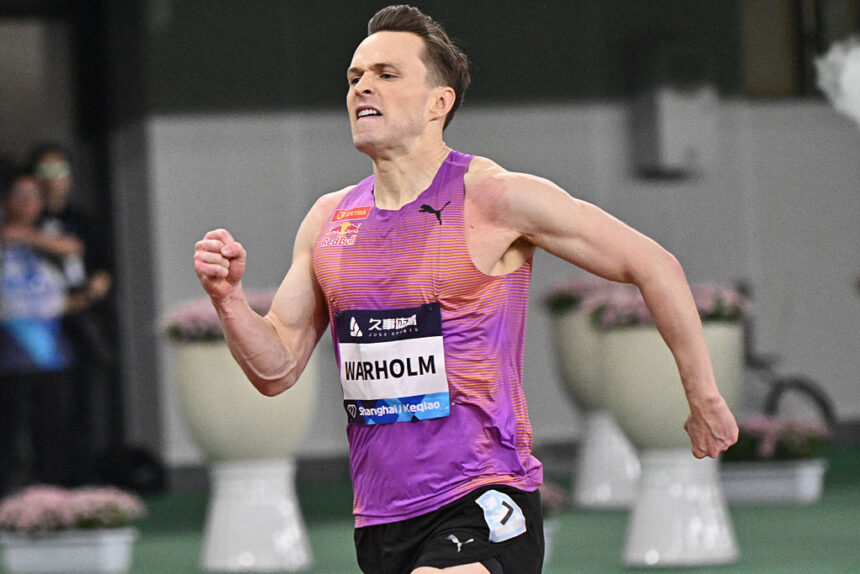Norwegian 400m hurdler and coach Leif Olav Alnes talk to Cathal Dennehy about the art of overcoming serious injury and pushing the limits of possibility
We didn’t talk about this before the Olympics – or indeed at the Olympics. As the world’s media pressed Karsten Warholm in Paris for the reason why he’d been convincingly beaten by his great rival, Rai Benjamin, the Norwegian chose not to go there.
He didn’t lie, but he did omit some key context – not wanting to be the athlete who raises the shield of excuses after coming up short. But the reality? Warholm struggled through last year with a chronic hamstring tendon issue, one that limited both the quantity and quality of his training.
“Those two work hand in hand,” he says now. “The volume comes first and then comes the quality. You can’t do all the training you want and, mostly, you can’t do it at the pace you want. I could run with it, but it was not ideal.”

Warholm kept the issue quiet all season, only telling the Norwegian media in the autumn. While it almost certainly hampered his performance in Paris, where he ran 47.06 to finish second to Benjamin’s 46.46, you won’t find him pointing to it as the reason he didn’t win.
And Warholm’s coach, Leif Olav Alnes, is just the same. “Complaining and making excuses after losing doesn’t help, it doesn’t change the result,” says Alnes. “And you should remember that, on your winning day, your opponent could post a lot of excuses. It doesn’t matter. You have to live with it. You win or you learn.”
Warholm, sitting alongside him, nods in agreement.
It’s 10 years since the pair began working together, and while there have been plenty of lows amid the many highs, 2024 proved a challenging year for both due to the tendon issue. “When you have to reduce the pace, you have to reduce the amount [of training] and you have to increase the time between the times you stress it,” says Alnes. “So, it’s actually biting you everywhere.”
Still, they did all they could, with Warholm going to Paris as the (slight) favourite after clocking 46.73 to win in Monaco a few weeks before. Given the issue he’d been dealing with all year, his silver medal could be seen by many as a triumph. But Warholm is too competitive, and too accomplished, to see it that way.
“I feel like I lost that race,” he says. “I still thought, on the day, that I could do it. It wasn’t a good race for me at all. Of course, in the Olympics, it stinks a bit more but I’ve gotten over it in that sense. It fuels the fire within you.”
Warholm said he “messed up hurdle nine”, having to reach for it due to fatigue, but knows he didn’t produce what he was capable of on the day – even if his preparation played a part.
“I didn’t feel what I did was representative for my level, but it’s the name of the game,” he says. “Getting to a championship without any trouble is also a part of the task, and I couldn’t do that. I have to see it as a failure [because] that happened – and it’s on us.”
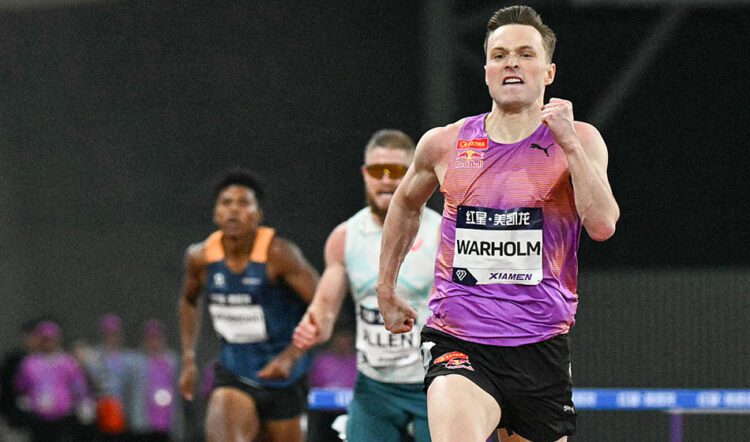
Of course, another injury soon followed, Warholm tearing his other hamstring a month after the Games in a head-to-head 100m race in Zurich against Mondo Duplantis. “So I went from having half a hamstring to two halves,” he laughs, adding that he believes the second one occurred due to him compensating for the first.
Warholm spent seven weeks rehabbing that in the autumn before returning to full training and, with a clean bill of health entering 2025, he and Alnes opted to bypass the indoor season. That was primarily so they could lay down a big foundation of training, with Alnes saying they essentially “moved the indoor season to China” – Warholm opening his racing year with two Diamond League races in Xiamen and Keqiao.
He won both, smashing his 300m hurdles world best with 33.05 in Xiamen and clocking 47.28 in Keqiao despite clattering two barriers. He says the Xiamen run showed “the speed is there over the hurdles”, while Keqiao was a “very messy race”.
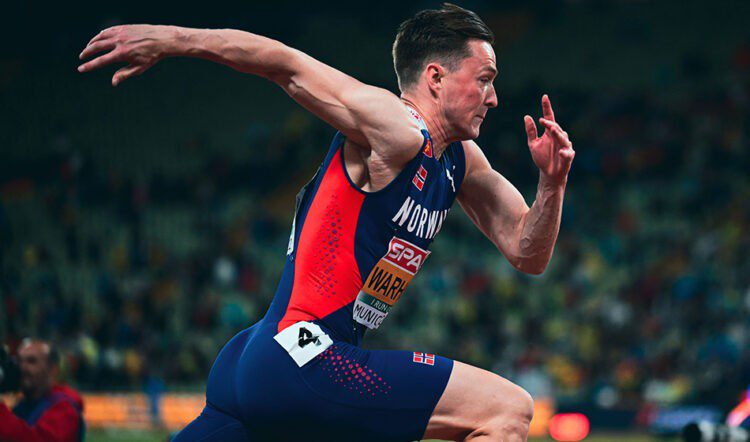
Warholm will take on his two biggest rivals – Benjamin and Alison dos Santos – at the Oslo Diamond League on June 12 and in Stockholm three days later, the trio clashing over 300m hurdles in the former and 400m hurdles in the latter. They rarely meet outside championships, their brilliance often witnessed in isolation, with each making statements to each other from across the world. As Warholm said in Keqiao: “You always want to use every occasion to send a message. Today, the message I sent is that the potential is very good if I can clean up the mistakes.”
He’s “pretty sure” the 33-second barrier will fall in Oslo and, in truth, his coach thought it would go in Xiamen. “I knew he was in that territory,” says Alnes. “But it was a little chilly, even for a Norwegian.”
Alnes says this part of the season is about “letting the work grow – taking the foot a little bit off the pedal, to try to feel a little lighter in the body.”

Warholm, of course, spends much of the year carrying the fatigue of a training programme that has few parallels. On a hard day, he’s at his training facility for eight hours. On easy days, he’s there for four. His background as a multi-eventer – Warholm was a world under-18 champion in the octathlon – built a durability that makes such days routine. Mondays and Fridays are “very hard”, he says, with Wednesdays “slightly hard” and Tuesdays, Thursdays and Saturdays are all about recovery. Sunday is typically a day off.
Alnes, whose stand-up-comic energy disguises one of the most innovative, intelligent minds in the sport, has long experimented in his approach. The reason Warholm spends so long at the track each day is not only about increasing volume but allowing for better intensity.
“Most of it is resting,” says Alnes. “It’s a burst of quality and, by resting during the day, you’re able to get a bigger volume, more repetition, higher quality.”
His warm-up includes varied amounts of running, jumping and strengthening exercises, with Warholm often springing up stairs. He then hits the skillmill – a curved treadmill – which is where the really hard graft begins. “Coach makes me run one minute at 30 kilometres an hour, getting some lactic [acid], then going out and running hurdles with the lactic in your legs. That’s a very tough session.”
Warholm is 29 now, and the right training recipe has been refined over many years. “I think we’ve really broken the code for how to get me in the best shape possible,” he says. “As long as we can get through it healthy, we know if we do this stuff, we will be very good. But pushing every week, day in, day out, comes with a lot of risks. Before, when I was running 48 seconds, there wasn’t that much of a risk but now, trying always to push 46 and hopefully 45 again, it’s a lot more risk and I think you see it in the history: it’s been a couple of injuries during the last years. But this is still the only way that makes sense, to try and push the level.”
The one issue with creating a masterpiece? It can make everything that follows feel a little anticlimactic, leaving its creator tormented in their quest to reproduce it. In Tokyo four years ago, Warholm splashed an all-time great performance across the Olympic canvas – his 400m hurdles world record of 45.94 remaining untouched, untroubled, ever since. According to World Athletics’ scoring tables, it equates to a 42.75 400m, 1:39.70 800m or 3:23 1500m. In other words, it’s fairly out of this world.
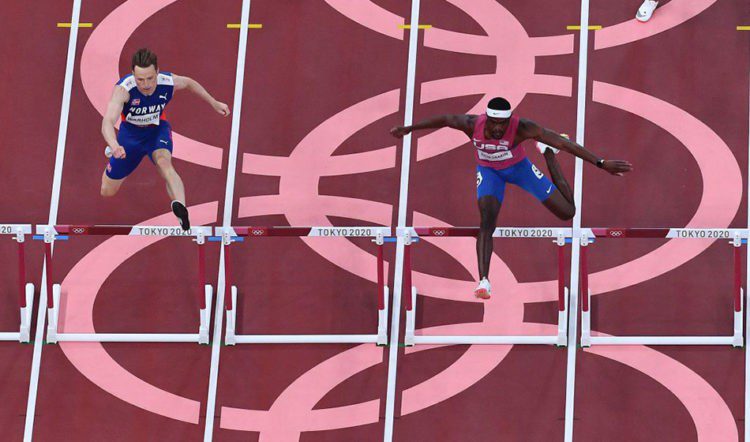
Does he consider it the perfect run? “I think, given what we had in the tank in 2021, it was pretty close to perfect,” he says. “But still we see a lot of things that we think, in theory, we can improve. It doesn’t mean you will. You can always say I want to change up something on hurdle nine and 10 but you still have to do the first eight hurdles just as fast as in Tokyo. But my last 100 metres has always been the most challenging. They were not perfect in Tokyo as well, even though they were one of my better [races]. We think we can improve it, but it will be very difficult.”
And as for Alnes? “I totally agree that we probably maximised the result on a very important day, as did many of those who ran, which leads me to the conclusion the conditions were very good.”
Alnes believes the pandemic aided performances in Tokyo: “A lot of athletes were depressed by the fact they decided to postpone it,” he says. “I decided to come into training the day we found out [and said]: ‘Yes, we got another year!’”
Alnes doesn’t want to predict if his star protégé can go faster “because well done is so much better than well said”, but he says: “Of course, we try to improve, and it’s better to stumble in the right direction than to walk vigorously in the wrong way.”
The inference is that, occasionally, they’ll get it wrong, but that’s the price of pushing the limits of human performance.
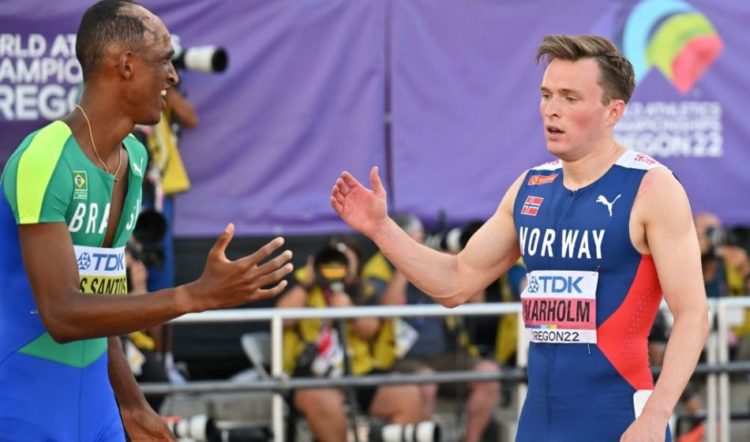
In their bid to go faster, they’re excavating every possible area of improvement. “If you said something really smart now, we would take it and then discuss it,” Warholm tells me and, once I assure him that won’t happen, we talk about an area that does help – shoe technology.
At the Tokyo Olympics, Warholm called out Nike’s super spikes as “bullshit”, comparing its thick midsole to a trampoline, but he has since changed his outlook on such technology. Following the 2023 World Championships in Budapest, he flew with Alnes to Vietnam to help Puma develop the ‘Berserker’ spike that he wore in Paris last year. At just 140g, it’s much lighter than its rival but if there’s one thing that sets it apart, it’s the ‘claw’ – which juts out from the front of the shoe.
The origin of that came from Warholm shooting a commercial for a Norwegian salmon company. “We had a thousand-frames-per-second camera, really high-tech stuff, that got us beautiful pictures,” he says. “We ran in the shoe that didn’t have the claw because, of course, it wasn’t invented yet, and you could see how the take-off was really slipping and how much power got lost.
“That’s how we came up with the claw which first started as nails or screws just to see if that worked and after that worked, we got it implemented in the carbon plate.”
The same principle was later used for the plate in Puma’s current super shoe, the Fast-R Nitro Elite 3, which has been found to give a 3.5 per cent improvement in running economy over other top-of-the-line racing shoes. Alnes says the ‘claw’ increases ground contact time, but improves a more important metric.
“At the end of the day, it’s all about speed,” he says. “Performance is created while you’re on the ground. So it’s storing elastic energy – that’s the big change from the time when you basically ran barefoot. The shoe Karsten won with in Tokyo, I think that’s the last time someone wins in a shoe – a stiff plate with nails on. A shoe used to be a shoe. Now it’s a musical instrument. You have to learn how to play it. If you’re a drummer, you shouldn’t try to play the violin.”

Warholm will run in “more or less” the same spike this year, with some tiny adjustments. “Some places you want stabilisation so you have to add weight, others you don’t so you can take it off,” he says. “It’s fascinating. I like to work with it. Of course, you make mistakes on the way too but that’s just learning, and we don’t have to pay the bill for it, so that’s very nice.”
They’ve also been experimenting with his stride pattern. In the last two Olympic finals, Warholm ran with 13 steps between barriers up to hurdle nine, then 15 to the last, but he’s been “working a little bit” more with 14 steps since last year. “It’s not a thought I want to let go, but it’s hard changing,” he admits. “For an old dog to learn new tricks – it takes time.”
He will go back into a heavy training block in the middle of the summer, laying more foundation for September’s World Championships in Tokyo. One place he won’t be seen this year is in Grand Slam Track, which he believes is a promising idea even if, in its current guise, it’s not a fit for him.
“It’s difficult because it’s in the US and competing two times every weekend is [challenging],” he says. “But, still, I like the thought of where they try to go and I think it’s also healthy for the sport. There are a lot of good thoughts there. They probably need some time to find their direction and that makes sense too, because it’s new.”
Alnes notes the upstart series “also gives opportunities to more athletes to do this full-time,” adding that it’s a “great thing because it’s not really a money sport.”

Alnes believes the Diamond League final could be “facing something difficult” this year, given its new slot before the World Championships could result in more athletes skipping it to focus on preparations. Warholm says it will be “interesting to see how different athletes deal with” the new finale to the season.
Warholm will be 32 when he gets the chance to regain the Olympic title in Los Angeles and he plans to compete at least until then, and perhaps well beyond.
“I will try to enjoy it as long as I can but there are a lot of things that have to be in place for a career to be that long,” he says.
“I don’t see any reason to slow down. The attitude is very important – you’ve got to have the passion and motivation to go on and, for now, we have it. But you never know when that feeling will disappear.”
For now, he has a more immediate focus: winning a fourth world title in Tokyo, a city that holds such blissful memories.
With his health restored, his speed exactly where he wants it, his mission for 2025 is straightforward. “To win as much as possible and continue to break records,” he says. “I’m hungry for more gold medals.”




